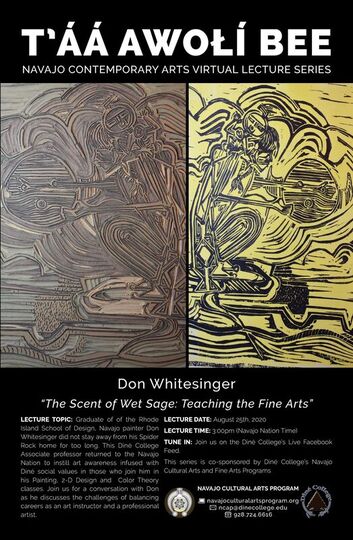Jeremy JonesNAS111: Introduction to Native American Studies Student
"Art is essential to me," he said. "I need to sleep and think art at all times." Individual artistic expression and cultural expression play off each other in his work. He is a Navajo painter, but he paints as himself. His art speaks for itself. Whitesinger’s Indigenous identity shows in his art. He presents himself in the context of his parents, teachers, and landscape. Many of his paintings depict his home communities of Chinle and Spider Rock. But, first and foremost, reveals himself as a human being. "Art is part of the fabric of being human," Whitesinger said. "Art is like a ceremony. Art has a purpose." That purpose, for Whitesinger, has to do with revealing and sharing yourself. For a practicing artist and a professor, the altruism of art and teaching are intertwined. Whitesinger abides by the Diné College paradigm of thinking, planning doing, and critiquing. Critiquing is an inherently communal activity, drawing people together and focusing them upon a single piece of art. At first, Whitesinger found it challenging to incorporate Navajo concepts into his classroom curriculum. "What you should teach and what you shouldn't teach," he said, comes with a great deal of debate. As with ceremonies, there is an element of "what you see here stays here." The artist must walk a line. He must reveal only what is his to reveal; he must only tell his story. In reference to one of his paintings of a Navajo deity, Whitesinger said, "Sometimes people see this, and they tell me I shouldn't do that. But it’s my own version of my existence here on the Navajo Nation, as far as myself and my dealing with certain things. When I paint, it makes me feel good about what I do and sometimes these images come out. So, I just work with it, and I stay with it. Sometimes people question my motives." His motives appear to be heartfelt and personal – a giving of himself to other but also a personal joy in expression. He paints valleys, skies, warriors, ceremonial dancers, and sons, using lines and bold complimentary colors. Whether plein air oil on canvas or prints on flags or thrift store art, Whitesinger creates abstract art that vibrates and bounces with color and that simultaneously reveals a memetic and emotional truth. "The use of lines and colors are essential to my artwork,” he said. "I try not to connect lines. When you connect them, it becomes a shape.” Shapes reveal too much. They are too literal. Shapes do too much of the talking. They close themselves off, connecting themselves. Shapes answer too many questions. Unconnected lines reveal and allow the viewer to enter the artwork, to draw their own conclusion. Whitesinger speaks for himself, but he speaks from within the context of his community. He connect using unconnected lines. His colors dance, a ceremonial dance, revealing just enough to let us feel a “divine breeze.”
0 Comments
Leave a Reply. |
Categories
All
Archives
October 2021
|
SocialsALL PHOTOS IMAGES ARE COPYRIGHT PROTECTED. PHOTO IMAGES USE IS SUBJECT TO PERMISSION BY THE NAVAJO CULTURAL ARTS PROGRAM. NO FORM OF REPRODUCTION IS PERMITTED WITHOUT WRITTEN PERMISSION FROM THE NAVAJO CULTURAL ARTS PROGRAM. |
Featured Pages |

